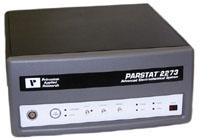|
Instrument Database:
Princeton Applied Research - PARSTAT 2273
| |
|

|
| |
|
| |
|
| Year of introduction |
|
| Status |
|
| Company |
Princeton Applied Research
|
| Categories |
Electrochemistry: Polarography
|
Overview
For more than two decades, the 273/273A has been the most popular instrument in the history of computer-controlled potentiostats/galvanostats. We knew how critical it would be that the next generation of this prestigious instrument continue to set the standard against which all other systems will be measured.
We would like to introduce you to the new benchmark!
Key specifications include:
- 2 A current max. (20 A boosted)
- 100 V compliance
- 1.2 fA current resolution
- >1013 Ohms input impedance
- <5 pF of capacitance
- 10 µHz to 1 MHz built-in analyzer for impedance
The PARSTAT® 2273 is the combination of renowned reliability, high current, and high compliance voltage of the 273A with the exceptional impedance capability, resolution, speed, and latest software techniques of our new PARSTAT® family. Plus we\\\\\\\'ve incorporated customer feedback to provide not only more internal maximum current but the ability to boost the 20 A and the ability to interface all the ancillary equipment customers need today for their unique research.
The 2273 is designed to be the most comprehensive potentiostat/galvanostat/FRA in your laboratory. Since no one can predict how research needs will evolve over the years, we\\\\\\\'ve designed the ultimate electrochemical tool to satisfy your need not only for today, but for tomorrow.
Applications
The PARSTAT® 2273 is a fit for any application in electrochemistry. Its high current, built-in EIS, and the ability to be boosted up to 20 amps makes it ideal for fuel cell and battery work. The unique combination of high-compliance voltage and wide current range allows it to handle any corrosion measurement required. For coatings, even the thickest coatings can be handled due to the high input impedance and low input capacitance. For voltammetry, the excellent resolution and sensitivity in the current are a must and are well suited for the most precise measurement.
|
|